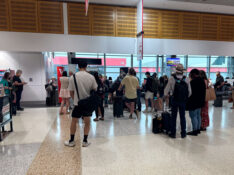How to Stop Airlines Losing Your Checked Baggage

Nobody wants to arrive at their destination without their checked baggage. Unfortunately, delayed and lost bags are just one of the risks associated with travel. The average airline typically misplaces around one in every 200 checked bags.
The only way to almost eliminate the risk of airlines losing your checked baggage is to travel with hand-luggage only. But even that’s not entirely foolproof because some airlines may occasionally force passengers to gate-check their carry-on bags when flights are full.
If you do need to check in a bag, there are ways that you can at least minimise the risk of your luggage going wayward. There are also things you can do to make life easier for yourself if your checked luggage doesn’t arrive with you.
Tips to minimise the risk of airlines misplacing your checked luggage
Here are a few ways that you can maximise the likelihood of your checked bags arriving with you…
Book direct flights
If your luggage needs to be transferred between multiple flights, this adds complexity and creates more opportunities for things to go wrong. For example, if your inbound flight is delayed, the airline might not have enough time to transfer your bag to the next flight. Booking direct flights removes the risk of misconnections.
If you can’t fly direct, avoid tight connections
Booking a longer connection time gives the airline more time to transfer your bag. Tight connections also don’t leave much buffer in case of even a small delay to the inbound flight.
Place the small sticker from your bag tag directly onto your suitcase
Paper bag tags are usually the only way for airlines to know where your bag is supposed to go. In the unlikely event that this falls off, the airline would realistically have no idea which flight your luggage is supposed to be on.
This is one of the reasons that airline bag tags have three small stickers at the end which you can peel off. These stickers each contain a barcode and some basic information about your flight number and destination.
It’s best practice to stick at least one of these stickers directly onto the outside of your suitcase. This provides a backup in case your bag tag somehow gets ripped off.
Also make sure you remove these additional stickers after each flight.

Priority baggage labels
If you’re flying Business or First Class, or you have frequent flyer status, you may be entitled to priority baggage. If so, make sure your bag has the priority tag attached to it.
This doesn’t always mean your bag will arrive first at the baggage claim – sadly, it often doesn’t. But if any bags need to be offloaded from your flight – for example, due to weight restrictions – the bags tagged with priority would be the last ones off.

Double-check that your bag is checked to where you think it is
This may sound obvious, but occasionally when checking in for trips with multiple flights in the same booking, the airline has tagged my bag to a different final destination than I was expecting. For example, it might only be tagged to an intermediate destination. Or, it could be tagged to my final destination despite my preference to pick up the bag at an intermediate airport where I have an overnight transit.
Always double-check the final destination printed on your bag tag, and keep your baggage receipt until you’re reunited with your bag at the end of your trip. Check-in staff can often re-tag your bag to a different airport if you request it.
If your flight is cancelled, make sure your checked bags are redirected
Occasionally, your flight could get cancelled or changed after you’ve already checked in. If the airline rebooks you onto a new flight, but you’ve already checked in a bag for your original flight, make sure that the airline correctly re-tags your bag for the new flight.
They will often do this anyway, but it can’t hurt to ask. I have been in situations where the airline forgot to do this.
How to make things easier if your checked luggage goes missing
Ultimately, you can’t completely eliminate the risk of airlines losing your checked baggage – only minimise it. But here are some ways to make life easier for yourself if your airline does unfortunately lose your bag…
Get Apple AirTags
Just because an airline might not know where your luggage is, doesn’t mean you don’t have to. Apple AirTags can track the real-time location of your luggage, making it much easier to retrieve it. This isn’t a gimmick – it really works.

If you don’t have an Apple device, there are also various alternatives available.
Do not pack valuables in your checked luggage
Even if you take all the right precautions, airlines might still lose your bag. I remember talking to Qantas Baggage Services once about a delayed bag and they (perhaps a tad too proudly) told me “don’t worry, it’s nothing personal – we also lose First Class bags all the time”.
It can happen to anyone, so please, please don’t pack medication, valuable or irreplaceable items in your checked bag. There’s always a small risk you won’t see them again.
Get a reference number
If your checked luggage doesn’t arrive on the carousel at your destination, don’t just leave the airport. Go to the baggage services counter and/or contact the airline immediately. Make sure the delayed or missing checked bag is logged in their system and that you have a reference number. If you need to follow up later, the airline will ask for this reference number.
Make sure your contact details are on your bag
Make sure your name and contact details (e.g. phone number or email address) are attached in some way to your bag. That way, if there is a problem with the bag tag, at least the airline will know who to try to deliver the bag to.
Don’t buy a black suitcase
If your checked bag goes missing, the airline will usually ask for a description of it. If you say “it’s black”, that won’t exactly make it stand out from the thousands of other black suitcases in their lost luggage room.
Pack spare clothes in your carry-on
Delayed bags usually arrive within 1-2 days. But that doesn’t help you if you need a clean change of clothes. I always pack spare clothes in my carry-on as this will at least get me through to the next day. By then, either my bag will have probably arrived – or I at least have a bit more time to buy new clothes.

Keep your receipts
It’s always a good idea to get travel insurance, as this will often cover your out-of-pocket costs in the event of a delayed bag. Some airlines also cover reasonable costs if your bag is delayed more than a certain amount of time.
However, airlines and insurers will almost always ask for receipts before they’ll pay for any new clothes, toiletries or other things you might have needed to buy.
If you intend to make an insurance claim, also make sure you keep any documentation the airline gave you regarding the lost bag. You may need this later as evidence to substantiate your claim.



Community Comments
Loading new replies...
Join the full discussion at the Australian Frequent Flyer →